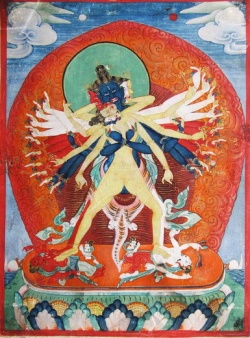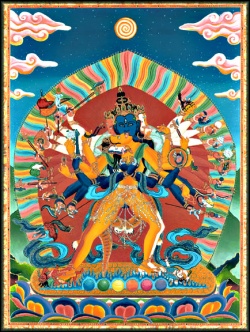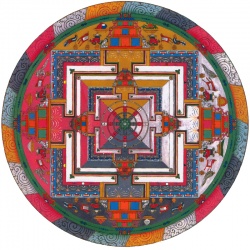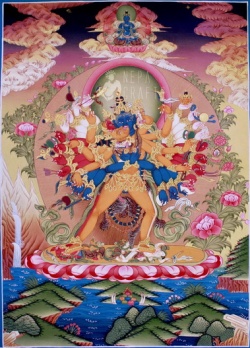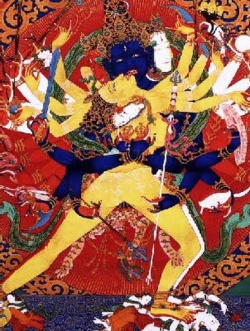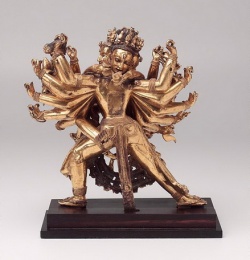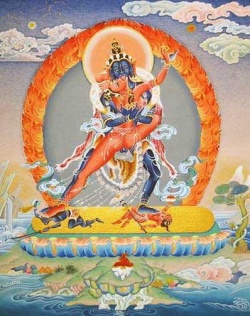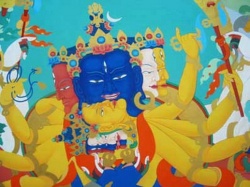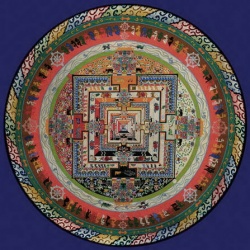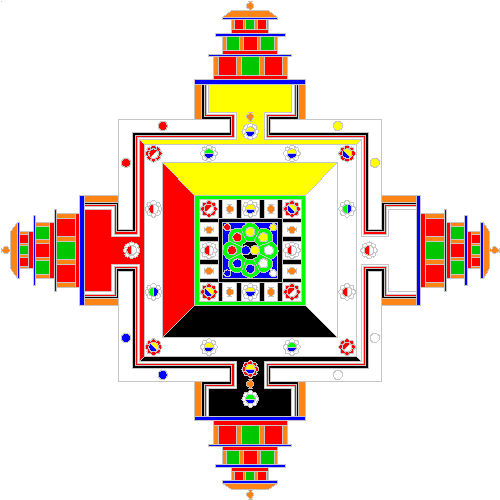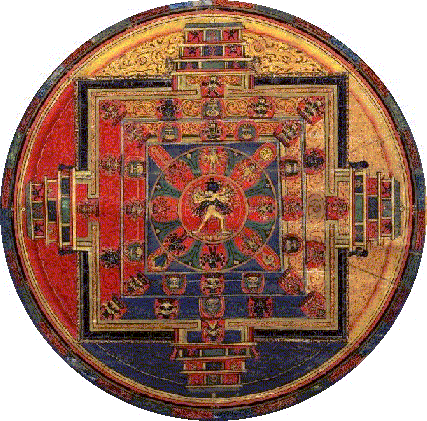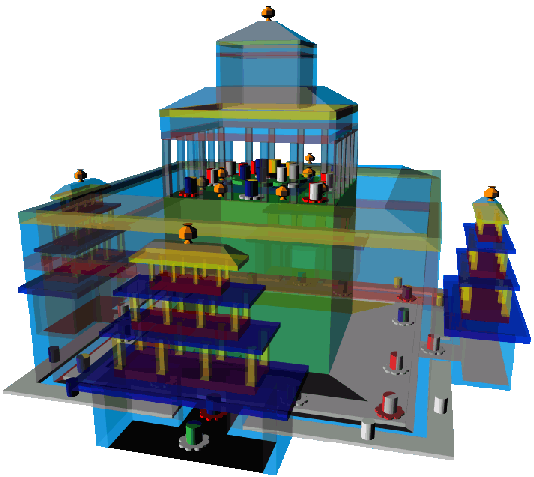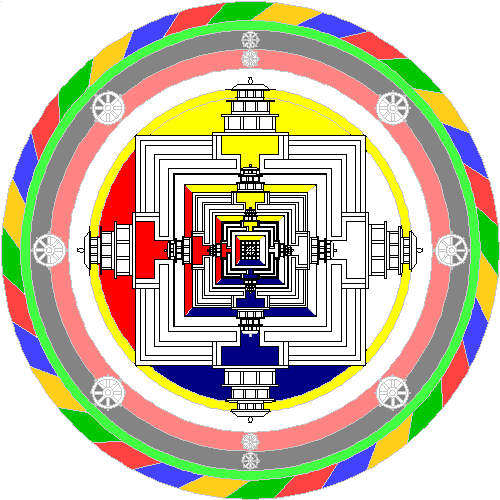The Kalachakra Mandala - Introduction
His Holiness the Dalai Lama from: 'The Kalachakra tantra, rite of initiation':
- "The Kalachakra system was one of the last and most complex tantric systems to be brought to Tibet from India. In recent years many Westerners have become acquainted with this tradition as various lamas have given the Kalachakra Initiation to large groups of people. I myself have given it several times in Western countries, as well as in India and Tibet. Such initiation are given on the basis of a mandala, the sacred residence with its residence deities, usually depicted in graphic form . The tradition I follow employs a mandala constructed of colored sand which is carefully assembled prior to each initiation and dismantled once more at the end. Due to their colorful and intricate nature, mandalas have attracted a great deal of interest. Although some can be openly explained, most are related to tantric doctrines that are normally supposed to be kept secret. Consequently, many speculative and mistaken interpretations have circulated among people who viewed them simply as works of art or had no access to reliable explanations. Because the severe misunderstandings that can arise are more harmful than a partial lifting of secrecy, I have encouraged a greater openness in the display and accurate description of mandalas."
The best known form of the Kalachakra mandala is the sand mandala, for which colored sand grains are painstakingly placed. This sand drawing represents a 3-dimensional palace of which every single detail has a symbolic meaning. A mandala is a symbolic representation of many aspects of a specific tantra. In the Kalachakra tantra, all elements of the mandala refer to the universe (outer Kalachakra), the body and mind (inner Kalachakra) and the practice (initiation, generation and completion stages). Every detail of the mandala, from each deity to every adornments of the building, refers to time and the universe (Outer Kalachakra), physical and mental aspects of Kalachakra and ourselves (Inner Kalachakra), and also to aspects of the practice (Alternative Kalachakra).
It should be noted that in the Kalachakra tradition, an unusual order of directions is followed in the description of the mandala. As usual (in Tibetan artwork), the Eastern direction (black) is directed to the viewer, or at the bottom of an image, but when going around the mandala, a somewhat complicated order is followed: clockwise from East to Southwest, clockwise from North to Northeast, and finally clockwise from West to Northwest.
This page describes the main layout of the mandala palace, other pages in the area for Initiates describe more in detail the deities which can be found at the various locations. The Kalachakra Mandala is like a huge palace, with 5 distinct floor levels:
- At the ground level is the Body Mandala, measuring 200 by 200 armspans, and it has 4 huge entrance ways in the main directions.
- Within the Body Mandala, on a platform of 100 armspans high, comes the Speech Mandala with a floor surface of 100 by 100 armspans, which looks very similar to the Body Mandala.
- At the center of the Speech mandala, on a platform 50 armspans in height, comes the Mind Mandala, with a floor surface of 50 by 50 armspans, which looks again very similar to the Body Mandala. The Mind Mandala has two more floor levels, the Exalted Wisdom Mandala and the Great Bliss Mandala.
- The Exalted Wisdom Mandala is raised 25 armspans above the floor of the Mind Mandala and its floor measures 25 by 25 armspans.
- On a slightly raised platform is the central Great Bliss Mandala, with a large green lotus on which the main Deity Kalachakra with his consort Vishvamata resides, surrounded by the 8 Shaktis.
- The top of the roof of the Great Bliss Mandala is at a height of 200 armspans.
THE CENTRAL MIND MANDALA
There are various traditions in depicting the mandala; in the type of Mind Mandala below on the left, all the deities are depicted as dots of sand, but in the thanka-painting of the Mind Mandala below, the most important deities are depicted.In the last case, proportions of the mandala are somewhat distorted in the center, otherwise the deities would not fit.In the Kalachakra tradition blue and black are often interchanged, so for example, deities of black color can be depicted as blue.The complete mandala of Kalachakra is built up in five distinct floors. The ground floor is the Body Mandala, the first floor is the Speech Mandala, and the highest three floors are part of the Mind Mandala.
- To explain what happens in this complex construction, we start from the center of the mandala, see the schematized image below of the isolated Mind Mandala which holds some 70 deities.
- The central area surrounded by the black frame (vajra wall) is the Great Bliss Mandala, representing the experience of Emptiness and Great Bliss. It is located on the highest, fifth floor of the complete body, speech and mind mandala
- In the center is a green lotus, with on its central (black Kalagni) disc, Kalachakra and Vishvamata are represented as blue and yellow dots.
- On the green lotus, each of the eight leaves is occupied by a Shakti.
- Around the lotus, on the blue floor of the Great Bliss Mandala, are four implements: white conch, red wooden gong, a black wish-granting jewel and a yellow wish-granting tree which represent the Buddha's Body, Speech, Mind and Exalted Wisdom respectively.
The surrounding area within the green line contains black pillars (in this image they are projected onto the floor) which carry the roof. This is the Exalted Wisdom Mandala, which represents the Subtle Mind and is on the fourth floor of the mandala.
Between the pillars are the 8 pairs of Tathagatas, seated on lotus seats, and vases.
The following area is divided in 4 quarts of different colors, showing the floor of the Mind Mandala, which is on the third floor.
This outer area represents the Coarse Mind, located on the second floor, and it is surrounded by a three-coloured wall.
On the white ledge (lhanam) just within the wall, 12 couples of Bodhisattvas are seated.
In the entrance gates, wrathful protecting deities are located, as couples.
In the four main directions, the porticos or entrance gates are depicted; in fact, they stand upright in the full 3D mandala, but are "flattened" for imaging in 2D.
Outside the mandala wall is also a white ledge, on which offering goddesses are located.
Below image is a 3D-view of the Mind Mandala. Not all dimensions have been officially verified, but it should give a good overall impression. All ornamentation is left out to create a clearer image, but note that even the ornaments do have profound symbolic meaning. The deities are represented as cylinders in the correct color. Deity pairs are represented as two half-cylinders.
THE FULL BODY, SPEECH AND MIND MANDALA
The image below represents a simplified 2D version of the complete mandala, as in the sand mandala, but not containing any deities or ornaments. In the center is the Mind Mandala, which is surrounded by the Speech and Body Mandala, which are similarly shaped.
Surrounding the central Mind Mandala is the Speech Mandala which represents the Enjoyment Body of the Buddha (Sambhogakaya). This mandala houses 116 deities and lies on the second floor of the mandala. On the white ledge (lhanam) are 80 deities, the Yoginis of the Speech Mandala, they represent for example the 80 minor marks of a Buddha.
The Body Mandala represents the Form Body of the Buddha (Rupakaya) and it surrounds the Speech Mandala. The Body Mandala is placed on the first floor at ground level. Including the deities in the surrounding cemetery grounds (depicted as wheels), it contains 536 deities. On the white ledge (lhanam) just inside the outer walls, are 12 animals (visible on the sand mandala, not here), depicting the 12 months of the year. Each carries a lotus with 28 petals on which a deity is placed, and a deity pair in the center which represents new moon and full moon; together these represent the 30 lunar days in a month. The number 360 also refers to the sets of 360 breaths we take in 60 cycles every day (adding up to 21,600 breaths per day).
